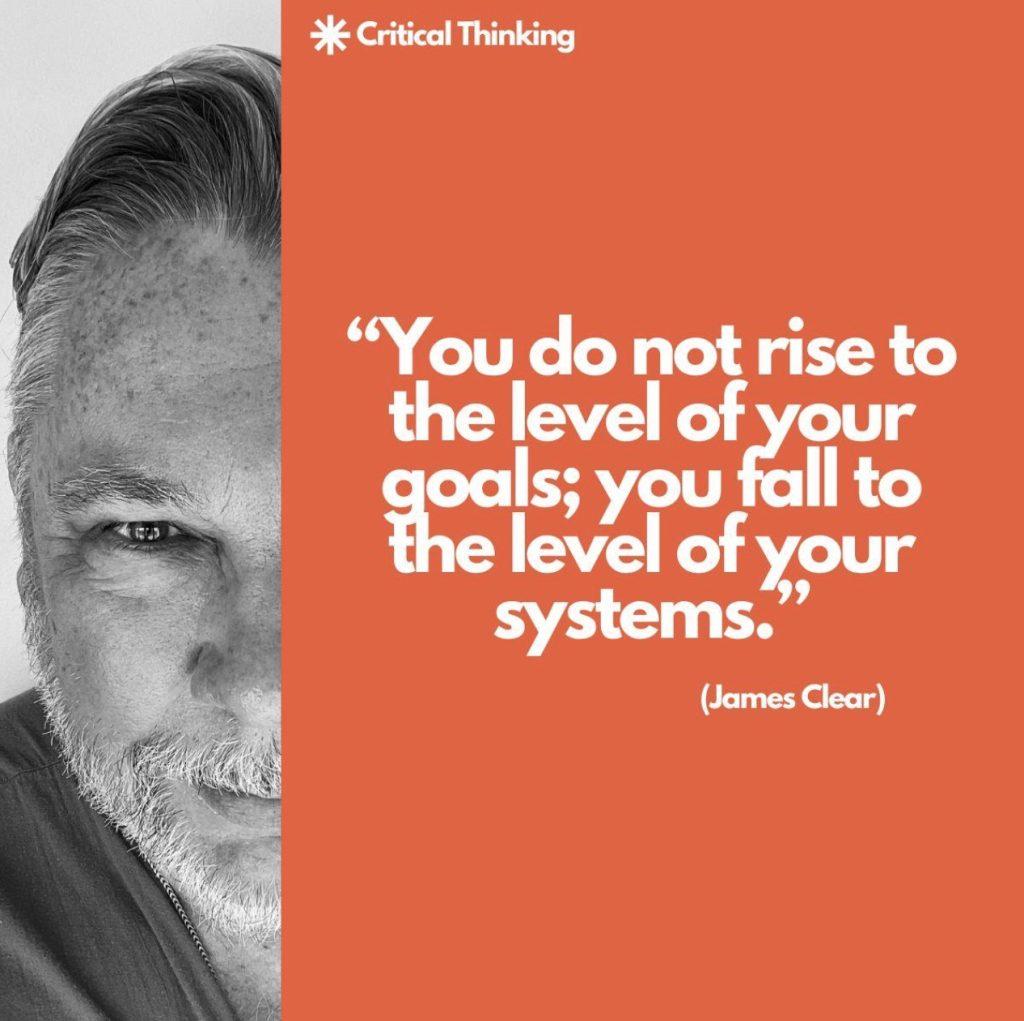By
Simon Crawford Welch, PhD

If leadership used to be about charisma and gut instinct, today it feels more like flying an airplane through fog: dashboards blinking everywhere, pings stacking up, ten “urgent” metrics before coffee. In that kind of noise, the leaders who win aren’t the ones who stare at more charts; they’re the ones who build better systems and ask better questions. James Clear, in his book “Atomic Habits”, captures the essence in a single sentence: “You do not rise to the level of your goals; you fall to the level of your systems.” That line isn’t just motivational – it’s mechanical. Systems are the routines, cadences, checklists, and if-then rules that make good decisions and good execution the default, even on messy days when plans blow sideways.
The Fog of Data (and Why Systems Matter)
The modern workday makes systems non-negotiable. The average knowledge worker spends roughly 28% of a week on email and another ~19% searching for information. Add the cognitive cost of interruptions and it gets worse: after a disruption, it takes about 23 minutes to regain focus. Meanwhile, 40–45% of daily actions are habitual. Put those facts together and you see the real problem: most teams don’t suffer from a lack of data; they suffer from a lack of default behaviors that protect attention and convert information into action. A good system lowers the cognitive tax of constant choosing. It turns overwhelm into a predictable flow: collect what matters, clarify what it means, choose the next move, check the result, repeat.
Goals Set Direction. Systems Deliver.
Goals still matter. They point north. But goals without systems are like pointing north without a road. “Habits are the compound interest of self-improvement,” Clear writes, and systems are how you bank those deposits. Consider his 1% rule: improve just 1% each day and you’re roughly 37 times better after a year (1.01^365 ≈ 37.8). In an organization, that looks like making a handful of high-value behaviors frictionless: clean data capture at the source; a weekly rhythm where the same few metrics are inspected in the same order; specific thresholds that trigger pre-decided actions; short post-mortems that produce one concrete process change. Leaders who win don’t chase occasional heroics; they install quiet systems that make small wins inevitable.
Critical Thinking: The Guardrail That Keeps Systems Honest
Systems without critical thinking turn rigid fast. Critical thinking is the quality control that keeps a system honest. Before you drown in dashboards, ask: What decision are we making, by when, and what evidence would change our mind? Without framing the decision first, you end up doing trivia night with metrics. Confront vanity metrics head-on: if a number can rise while the business gets worse, it’s not management – it’s entertainment. Bring base rates into the room by asking, “What typically happens in similar situations?” It’s a simple way to puncture optimism bias. And don’t just invite dissent; formalize it. Red-team your favorite plan for fifteen minutes and make someone argue against the idea you love. The most valuable opponent is the one already in your building.
If you want proof that simple systems beat memory and heroics, look at healthcare. When hospitals adopted a straightforward surgical checklist, complications fell by more than a third and deaths nearly halved across test sites. Different domain, same principle: clear steps plus disciplined review outperform adrenaline and good intentions – especially under pressure. Business is no different. A lightweight checklist for launching a campaign, handing off a customer, or closing the books will save more money than the flashiest dashboard because it prevents errors you never have to fix.
A Lightweight System Stack You Can Actually Use
Picture a leadership rhythm that’s intentionally boring – in the best way. Compress your attention to a one-page scorecard with the vital few. Each metric has an owner, a target, a trend, and a next action – because a metric without an owner is just a wish. Hold the same weekly conversation at the same time with the same agenda: review the numbers, note where the story diverges from expectation, agree on the smallest test you’ll run before next week, and decide in advance what you’ll do if a threshold is crossed. That last part matters. Clear is relentless about making the desired behavior the path of least resistance. Translate that into “implementation intentions” for your team:
- If inbound leads drop 15% vs. baseline, then activate the dormant nurture sequence within 24 hours.
- If cycle time exceeds 72 hours, then the owner diagnoses the bottleneck and returns with a one-slide fix by Friday.
Add one more habit: decision journals for material bets. It sounds fancy, but it’s just a dated note that records the situation, the options you considered, your expected outcomes, key uncertainties, and what would falsify your bet. Review those notes monthly. Over time, you train the group away from hindsight bias (“we always knew”) and toward learning loops (“here’s where our model was wrong”). That’s critical thinking, operationalized.
Manage Attention, Not Just Information
With so much data on tap, the scarce resource isn’t information – it’s focus. Working memory can juggle only about four items at once on average, which means you must externalize complexity: get it out of your head and into systems. Batch the noisy work in two or three windows for email and chat, then defend two hours of deep work on your calendar like a revenue line. Name your “vital few” each morning – three outcomes for the day, not thirty – and say them out loud at the end of the stand-up. If a step repeats, template it. If a template repeats, script it. If a script repeats, automate it. That ladder – template → script → automate – quietly returns hours you can reinvest in judgment and coaching.
Make It Identity-Based
There’s a cultural dimension here that Clear makes practical through identity. “Every action you take is a vote for the type of person you wish to become.” Teams vote the same way. If you want a culture of critical thinkers, give it a name and a ritual. “We test assumptions” becomes real when every proposal lists three assumptions and how they’ll be tested in the first two weeks. “We ship clean work” becomes real when nothing customer-facing goes live without a two-step peer review. Culture is less what you preach at the all-hands and more what your systems make unavoidable on Tuesday afternoon.
Data-Driven ≠ Data-Dazed
Being data-driven doesn’t mean being data-dazed. The companies that benefit most from analytics aren’t hoarding numbers; they’re disciplined about converting numbers into choices. Research on data-driven decision making has found meaningful gains – several percentage points in productivity and profitability – among firms that operationalize analytics. The edge didn’t come from more dashboards; it came from tighter loops between signal and action. A simple three-question filter keeps you honest: What problem are we solving? Which metric would disconfirm our favorite idea? What’s the smallest test we can run this week? When a number triggers a pre-decided move, analysis paralysis loses its grip.
Embrace the (Intentionally) Boring Drumbeat
Perhaps the hardest part is accepting the intentional boringness of good systems. There’s no soundtrack for a team that runs the same clean meeting cadence, audits the same five metrics, and updates the same single source of truth. Yet that drumbeat is what compounds. It reduces rework, accelerates learning, and scales your leadership because the system carries the cognitive load while you focus on judgment calls, mentoring, and strategy. Clear puts it simply: “Success is the product of daily habits – not once-in-a-lifetime transformations.” In a world where the data never stops, that’s not self-help fluff; it’s an operating philosophy.
Set goals to aim the work, then build systems to carry it. Use critical thinking as your guardrail so the system never turns into dogma. Protect attention as fiercely as you chase insight. Make identity the glue that turns good intentions into non-negotiable rituals. And when the fog gets thick and the dashboards multiply, remember the line worth writing at the top of your agenda each week: you won’t rise to the level of your goals – you’ll fall to the level of your systems. Make those systems worthy of where you’re going, and let compounding do the quiet, extraordinary work that heroics never will.
Simon Crawford-Welch, PhD, is the Founder, The Critical Thought Lab. Author of “American Chasms: Essays on the Divided States of America” & “The Wisdom of Pooh: Timeless Insights for Success & Happiness” (Available on Amazon) www.linkedin.com/in/simoncrawfordwelch



